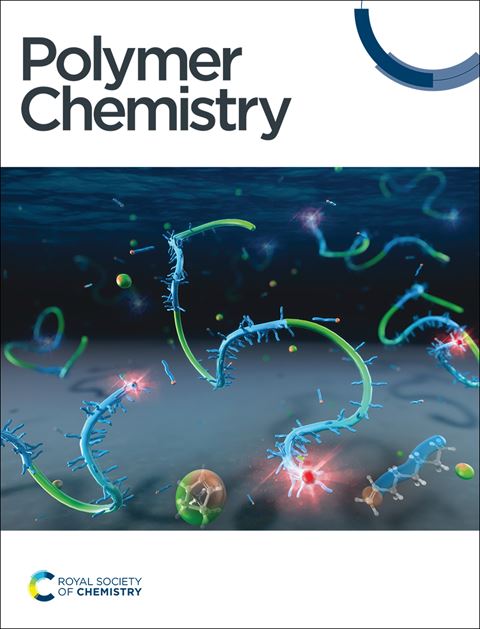Visible Light-Promoted Nickel-NHC Photocatalysts for Free Radical Photopolymerization and 3D Printing Application
IF 4.1
2区 化学
Q2 POLYMER SCIENCE
引用次数: 0
Abstract
The evaluation of NiII complexes bearing bidentate N-heterocyclic carbene (NHC) ligands has shown great potential as catalysts in various reactions. However, their luminescence properties and photocatalytic applications remain underexplored. Two novel nickel-based NHC complexes, [Ni(py-NHC)2](PF6)2 (NiC1) and [Ni(ph-NHC)2] (NiC2), were synthesized with ligands N-Mesityl-N’-2-pyridylimidazolium Tetrafluorophosphate and 1-Mesityl-3-phenyl-1H-imidazol-3-ium Tetrafluorophosphate, respectively. The complexes were thoroughly characterized using spectroscopy techniques, including FTIR, UV-Vis, 1H NMR, and fluorescence, along with elemental analysis, cyclic voltammetry, and mass spectrometry. NiC1 and NiC2 exhibited emission properties and lifetime ranging of 3.8 and 9.1 ns, respectively. The photocatalytic properties of NiC1 and NiC2 were investigated for initiating free radical photopolymerization of ethoxylated trimethylolpropane triacrylate under violet light. This process incorporated di-tert-butyl-diphenyl iodonium hexafluorophosphate and ethyl dimethylaminobenzoate as additives. NiC2 achieved the highest monomer conversion under air or in laminate and was effective in on-off LED irradiation. Proposed oxidative and reductive mechanisms were supported by photolysis, fluorescence quenching, and electron spin resonance data. The optimized system was applied in 3D printing, producing smooth-surfaced, high-resolution patterns.用于自由基光聚合和三维打印应用的可见光促进型镍-NHC 光催化剂
对含有双齿 N-heterocyclic carbene(NHC)配体的 NiII 复合物进行的评估显示,它们在各种反应中作为催化剂的潜力巨大。然而,它们的发光特性和光催化应用仍未得到充分开发。研究人员分别用配体 N-甲基-N'-2-吡啶基咪唑鎓四氟磷酸盐和 1-甲基-3-苯基-1H-咪唑鎓四氟磷酸盐合成了两种新型镍基 NHC 配合物 [Ni(py-NHC)2](PF6)2 (NiC1) 和 [Ni(ph-NHC)2] (NiC2)。利用傅立叶变换红外光谱、紫外可见光谱、1H NMR 和荧光光谱等光谱技术以及元素分析、循环伏安法和质谱法对这些配合物进行了全面的表征。NiC1 和 NiC2 的发射特性和寿命范围分别为 3.8 和 9.1 ns。研究了 NiC1 和 NiC2 在紫光下引发乙氧基化三羟甲基丙烷三丙烯酸酯自由基光聚合的光催化特性。该工艺中加入了二叔丁基二苯基碘鎓六氟磷酸盐和二甲氨基苯甲酸乙酯作为添加剂。在空气中或层压板中,NiC2 的单体转化率最高,在开关式 LED 辐照中也很有效。提出的氧化和还原机制得到了光解、荧光淬灭和电子自旋共振数据的支持。优化后的系统被应用于三维打印,可打印出表面光滑的高分辨率图案。
本文章由计算机程序翻译,如有差异,请以英文原文为准。
求助全文
约1分钟内获得全文
求助全文
来源期刊

Polymer Chemistry
POLYMER SCIENCE-
CiteScore
8.60
自引率
8.70%
发文量
535
审稿时长
1.7 months
期刊介绍:
Polymer Chemistry welcomes submissions in all areas of polymer science that have a strong focus on macromolecular chemistry. Manuscripts may cover a broad range of fields, yet no direct application focus is required.
 求助内容:
求助内容: 应助结果提醒方式:
应助结果提醒方式:


